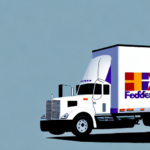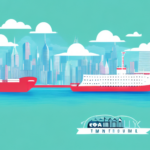How LTL Shipping Can Enhance Your E-Commerce Logistics
As e-commerce continues to expand, efficient logistics management becomes crucial for ensuring customer satisfaction and optimizing business operations. One increasingly popular shipping option is LTL (less-than-truckload) shipping. This article delves into the benefits, challenges, and strategies for leveraging LTL shipping to streamline your e-commerce logistics.
Understanding the Basics of LTL Shipping and Its Role in E-Commerce
LTL shipping involves transporting multiple shipments from different customers on a single truck. Unlike truckload shipping, where the entire truck is dedicated to one shipment, LTL allows businesses to share shipping space, making it a cost-effective solution. Typically, LTL shipments are under 10,000 pounds and exceed the size limits of standard parcel carriers, making them ideal for e-commerce businesses dealing with larger or heavier items.
For e-commerce logistics, LTL shipping offers a balance between cost and efficiency. According to the American Transportation Research Institute (ATRI), LTL shipping accounts for approximately 36% of all freight tonnage, highlighting its significance in the logistics ecosystem.
Businesses benefit from lower shipping costs since expenses are distributed among multiple shippers based on weight and distance. However, LTL shipping also presents challenges, such as a higher risk of damage or loss due to multiple handling points. Partnering with reputable carriers and ensuring proper packaging can mitigate these risks.
The Advantages of LTL Shipping for Small and Medium-Sized Businesses
Cost Savings
One of the primary advantages of LTL shipping is cost savings. Small and medium-sized businesses (SMBs) can avoid the high costs associated with trucking entire loads by paying only for the space they utilize. This makes LTL an affordable option for SMBs that need to ship larger items without the volume to justify truckload shipping.
Flexibility in Shipping Options
Flexibility is another key benefit. Many LTL carriers offer various shipping options, including guaranteed delivery times and expedited services, catering to businesses with time-sensitive products or deadlines. Additionally, specialized services like liftgate or inside delivery enhance convenience for businesses with limited loading facilities.
Environmental Sustainability
Environmental sustainability is also a significant advantage. By consolidating multiple shipments into a single truck, LTL shipping reduces the number of vehicles on the road, lowering carbon emissions. A study by the Environmental Protection Agency (EPA) indicates that optimizing freight can significantly reduce the transportation sector's carbon footprint.
Why E-Commerce Businesses Should Consider LTL Shipping for Their Logistics Needs
Handling Larger and Heavier Shipments
LTL shipping offers several benefits over traditional parcel shipping for e-commerce businesses. Firstly, it accommodates larger and heavier shipments that parcel carriers cannot handle. This is particularly beneficial for businesses selling bulky items like furniture or electronics.
Cost Efficiency
Cost efficiency is another compelling reason. LTL shipping helps businesses avoid surcharges and dimensional pricing that parcel carriers may impose on larger items, leading to significant savings. Additionally, LTL shipments are often palletized, ensuring products arrive in better condition compared to parcel shipments, which enhances customer satisfaction.
Environmental Benefits
From an environmental perspective, LTL shipping's consolidation of shipments contributes to reduced carbon emissions and less traffic congestion. This aligns with the growing consumer demand for sustainable business practices.
Flexibility and Customization
Furthermore, LTL shipping offers greater flexibility and customization. Businesses can choose from various service levels, such as expedited or guaranteed delivery, and request additional services like liftgate or inside delivery to meet specific logistical requirements.
Overcoming Common Challenges in E-Commerce Logistics with LTL Shipping
Extended Transit Times
While LTL shipping presents numerous advantages, it also comes with challenges. Extended transit times are a common issue, as LTL shipments often involve multiple stops for loading and unloading. Coordinating pick-up and delivery schedules can be more complex compared to direct parcel shipments.
Managing Paperwork and Documentation
Managing paperwork and documentation for LTL shipping is another hurdle, as it typically involves more detailed information and compliance with various regulations. However, these challenges can be mitigated by partnering with experienced carriers and utilizing advanced transportation management systems (TMS) that streamline documentation and provide real-time tracking.
Risk Mitigation
To maximize the benefits of LTL shipping, businesses should collaborate with reliable carriers that offer accurate transit times and robust tracking capabilities. Investing in proper packaging and labeling ensures shipments are handled with care, reducing the risk of damage or loss. Additionally, leveraging technology can simplify logistics management and enhance overall efficiency.
The Cost Benefits of Using LTL Shipping for Your E-Commerce Business
Shared Shipping Costs
LTL shipping offers significant cost advantages for e-commerce businesses. By sharing truck space with other shippers, businesses only pay for the portion they use, leading to substantial savings compared to truckload shipping. Many LTL carriers also provide volume discounts or special rates for frequent shippers, further reducing costs.
Improved Inventory Management
Flexibility in shipment sizes allows businesses to ship smaller quantities more frequently, improving inventory management and reducing the risks of overstocking or understocking. This agile shipping approach can enhance cash flow and operational efficiency.
Environmental Cost Savings
Environmental benefits also translate into cost savings. Efficient use of transportation resources lowers fuel consumption and maintenance costs, while businesses can potentially qualify for sustainability incentives or rebates.
Choosing the Right LTL Carrier for Your E-Commerce Logistics Needs
Carrier Experience and Network Coverage
Selecting the appropriate LTL carrier is critical for optimizing your e-commerce logistics. Key factors to consider include the carrier’s experience with e-commerce businesses, network coverage, and service offerings. A carrier with a robust network of terminals and flexible delivery options provides greater reliability and speed.
Cost, Transit Times, and Customer Service
Cost, transit times, and customer service quality are also essential considerations. Evaluating carriers based on their pricing structures, delivery performance, and responsiveness can help ensure a good fit for your business needs.
Technology Capabilities
Technology capabilities are increasingly important in carrier selection. Look for carriers that offer online tracking, real-time updates, and integration with your e-commerce platform. Seamless integration enhances shipment visibility and reduces errors, improving overall logistics efficiency.
For more insights, refer to our guide on choosing the right e-commerce platform.
Tips for Optimizing Your E-Commerce Logistics with LTL Shipping
- Consolidate Shipments: Combine multiple orders into a single shipment to reduce costs and simplify logistics.
- Coordinate Scheduling: Work closely with your carrier to align pick-up and delivery times, ensuring timely arrivals.
- Invest in Tracking Tools: Utilize tracking and visibility tools to monitor shipments and proactively address potential issues.
- Enhance Packaging: Use sturdy materials and appropriate cushioning to protect products during transit.
- Analyze Shipping Data: Regularly review shipping metrics to identify patterns and areas for improvement.
Proper packaging not only safeguards your products but also enhances brand reputation by ensuring items arrive in pristine condition. Additionally, analyzing shipping data helps in making informed decisions to further optimize your logistics strategy.
Case Studies: E-Commerce Businesses Benefiting from LTL Shipping
Furniture Retailer Expansion
Several e-commerce businesses have successfully integrated LTL shipping into their logistics strategies. For instance, a furniture retailer expanded its product range by utilizing LTL shipping to handle larger and more complex items efficiently. This approach enabled the retailer to offer a broader selection without incurring prohibitive shipping costs.
Outdoor Equipment Retailer Efficiency
Another example is an outdoor equipment retailer that reduced shipping costs and improved delivery times by consolidating shipments. By leveraging specialized delivery options offered by LTL carriers, the retailer enhanced customer satisfaction through reliable and timely deliveries.
These case studies illustrate the tangible benefits of LTL shipping in enhancing operational efficiency and customer experience for e-commerce businesses.
Integrating LTL Shipping into Your E-Commerce Strategy for Maximum Impact
Incorporating LTL shipping into your overall e-commerce strategy can drive significant growth and operational efficiency. Start by selecting the right carrier that aligns with your business needs and offers the necessary services and technology integrations. Optimize your shipment strategy by consolidating orders, enhancing packaging, and leveraging tracking tools to maintain visibility throughout the shipping process.
By integrating LTL shipping, businesses can achieve cost savings, improve delivery reliability, and expand their product offerings. This strategic integration ensures that logistics support the broader business objectives, fostering growth and enhancing customer satisfaction.
Future Trends in E-Commerce Logistics and the Role of LTL Shipping
Advancements in Technology
The e-commerce logistics landscape is poised for continued evolution, with advancements in technology and changing consumer expectations shaping the future. LTL shipping is expected to play an increasingly vital role, driven by trends such as real-time tracking, digital documentation, and automation.
Internet of Things (IoT) and AI-Powered Analytics
Technological innovations like IoT (Internet of Things) and AI-powered analytics will enhance shipment visibility and predictive capabilities, making LTL shipping more efficient and responsive. Additionally, the demand for faster and more customized shipping options will push LTL carriers to offer specialized services tailored to diverse business needs.
Sustainability Focus
As sustainability remains a priority, LTL shipping's inherent efficiency in consolidating shipments will continue to make it a preferred choice for eco-conscious e-commerce businesses striving to minimize their carbon footprint.
Comparing LTL Shipping to Other Freight Options for Your E-Commerce Business
While LTL shipping offers numerous benefits, it is essential to evaluate it against other freight options to determine the best fit for your business:
- Truckload Shipping: Ideal for businesses with high shipment volumes or exceptionally large items. It offers faster transit times and reduced handling but at a higher cost.
- Parcel Shipping: Suitable for smaller, lightweight items or time-sensitive deliveries. It provides quick delivery but may incur higher costs for larger shipments.
Ultimately, the choice depends on factors such as shipment size, volume, cost considerations, and delivery timelines. A hybrid approach, utilizing multiple freight options, can also be effective in meeting diverse logistical requirements.
Best Practices for Tracking and Managing LTL Shipments in Your E-Commerce Logistics
- Utilize Carrier Tracking Tools: Take advantage of the tracking capabilities provided by your LTL carrier to monitor shipment status in real-time.
- Maintain Regular Communication: Keep open lines of communication with your carrier and customers to provide updates and address any issues promptly.
- Invest in Transportation Management Software (TMS): A robust TMS can streamline shipment tracking, documentation, and reporting, enhancing overall logistics management.
- Proactively Identify Issues: Use tracking data to detect potential delays or problems early, allowing for timely intervention and resolution.
Implementing these practices ensures that your LTL shipments are managed efficiently, reducing the likelihood of errors and enhancing the overall customer experience.
In conclusion, LTL shipping is a valuable component of e-commerce logistics, offering cost savings, flexibility, and sustainability benefits. By understanding its fundamentals, selecting the right carrier, and adhering to best practices, businesses can effectively integrate LTL shipping into their logistics strategies, driving growth and improving customer satisfaction.




















